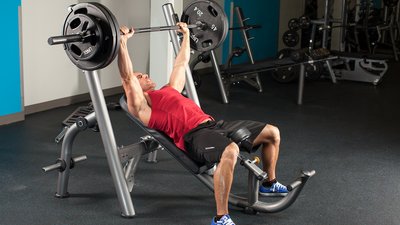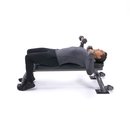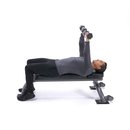When trying to pack as much variety as possible into your body-part routine, you search for new exercises to complement the basic foundational move you start with. It doesn't matter if they're multijoint or single-joint or anywhere from mild to wild—just so long as they're different.
But what if the exercise you need to complement your first move is the first move itself? That's the concept behind a training method called "bookends." You finish with the same exercise you started with, but by changing variables like reps, intensity, and rest periods, you can optimize hypertrophy (muscle growth).
Working the Front End
Let's say you want to bookend a chest workout with the dumbbell bench press, a solid mass-building movement. The first time you do the press, you'll be fresh and able to push your heaviest weights. I typically recommend pushing the lower end of the muscle-building rep range at the start of your workout, as low as 6 reps each set. That's great for building both strength and size.
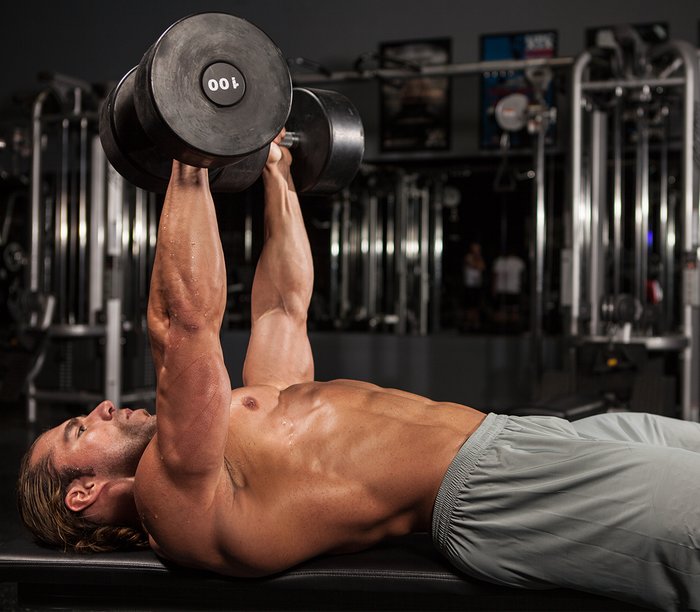
Dumbbell bench press
Using heavy weights in that rep range has a significant effect on two interlinked mechanisms related to hypertrophy: mechanical tension and muscle damage. Research suggests mechanical tension has the greatest influence on muscle hypertrophy.[1] The goal of heavy resistance training (technically called high-intensity training) is to put tension on the structural integrity of skeletal muscle and satellite cells.[2] This tension damages those cells, provoking an inflammatory response that leads to the production of proteins called myokines.[3] These proteins help release growth factors your body needs to grow more muscle.
Working the Back End
You need to change the way you repeat your beginning movement because your muscles are fatigued toward the end of the routine. Tired muscles can't generate the same degree of mechanical tension they can at the start with lifting heavier loads. You can take advantage of that muscle fatigue by ending your routine with a higher rep target.
Even with lighter weights, more reps can induce greater levels of muscle fatigue and metabolite accumulation. This sets the stage for an anabolic-hormone response; your body reacts to this metabolic stress by releasing insulin-like growth factor (IGF-1) and testosterone. This leads to increased muscle protein synthesis, which in turn leads to muscle growth.[4,5]
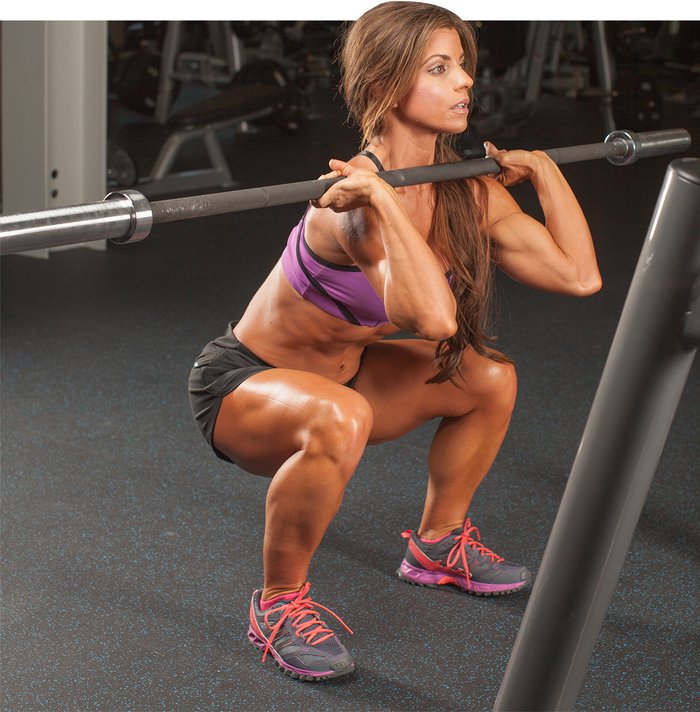
Even with lighter weights, more reps can induce greater levels of muscle fatigue and metabolite accumulation.
You can trigger your body's anabolic-hormone response by choosing a weight you can do for a slightly higher rep target, such as 3 sets of 12-15 reps. And by maintaining short rest intervals—say, 60 seconds—you can make sure your muscle tissue won't be completely recovered before you begin your next set. By preventing full recovery, you put higher levels of metabolic stress on your muscles, which helps them grow all that much more.
Bookend Basics
1. If your initial movement is technically challenging, it may be really difficult to keep good form when it's also done last.
Exercises like overhead dumbbell presses for shoulders, squats, and dumbbell bench presses require stability and balance. A severe muscle pump late in your routine can throw off your balance and increase your chance of injury. If you choose a challenging movement for your final bookend, ask someone to spot you, or use a power rack with the safety bars properly positioned. In some cases, you may want to try the machine version of the exercise, so long as it closely mimics your initial movement.
2. Training techniques are rarely tested in a laboratory setting, so don't assume that 3 sets of 12-15 reps is the only way to do your last movement.
Experiment with other finishing techniques, including dropsets and cluster sets. Find what works best for you.
Dropsets: Take the muscle to failure, reduce the weight about 25 percent, and continue to failure a second time.
Cluster sets: Limit the cluster set to a specific amount of time, then alternate between work and rest intervals within that time.
Big Bookend Chest Routine
- The workout does not contain warm-up sets. Perform as many as you need, but never take warm-ups to muscle failure.
- Choose a weight that allows you to reach muscle failure by the target rep listed.

BodyFit
$6.99/month- 2,500+ expert-created single workouts
- 3,500+ how-to exercise videos
- Detailed workout instruction
- Step-by-step workout tips
- Training at gym or at home
- Access to Workout Plans
- Access to Bodyfit App
- Store Discounts
Already have a Bodybuilding.com account with BodyFit? Sign In

What comes with BodyFit?

- Instructional Videos
Don't risk doing a workout improperly! Avoid injury and keep your form in check with in-depth instructional videos.

- How-to Images
View our enormous library of workout photos and see exactly how each exercise should be done before you give it a shot.

- Step-by-Step Instructions
Quickly read through our step-by-step directions to ensure you're doing each workout correctly the first time, every time.
One exercise, done at the start and at the end—each time with very different effects. That's one way to bookend greater results!
References
- Vandenburgh, H. H. (1987). Motion into mass: how does tension stimulate muscle growth? Medicine and Science in Sports and Exercise, 19(5 Suppl), S142-9.
- Toigo, M., & Boutellier, U. (2006). New fundamental resistance exercise determinants of molecular and cellular muscle adaptations. European Journal of Applied Physiology, 97(6), 643-663.
- McDonagh, M. J. N., & Davies, C. T. M. (1984). Adaptive response of mammalian skeletal muscle to exercise with high loads. European Journal of Applied Physiology and Occupational Physiology, 52(2), 139-155.
- Tesch, P. (1988). Skeletal muscle adaptations consequent to long-term heavy resistance exercise. Medicine and Science in Sports and Exercise, 20(5 Suppl), S132.
- Goto, K., Ishii, N., Kizuka, T., & Takamatsu, K. (2005). The impact of metabolic stress on hormonal responses and muscular adaptations. Medicine and Science in Sports and Exercise, 37(6), 955-63.


